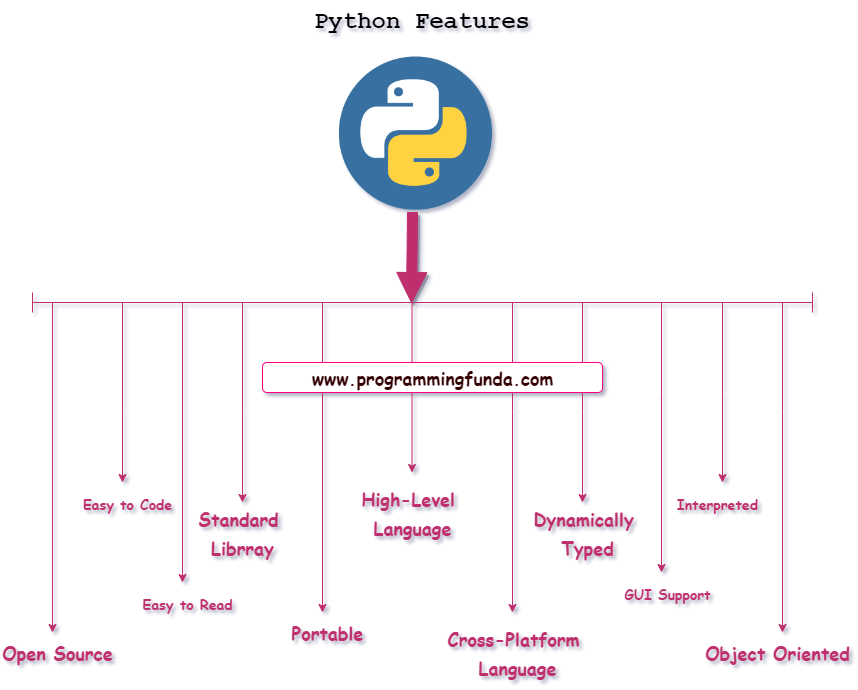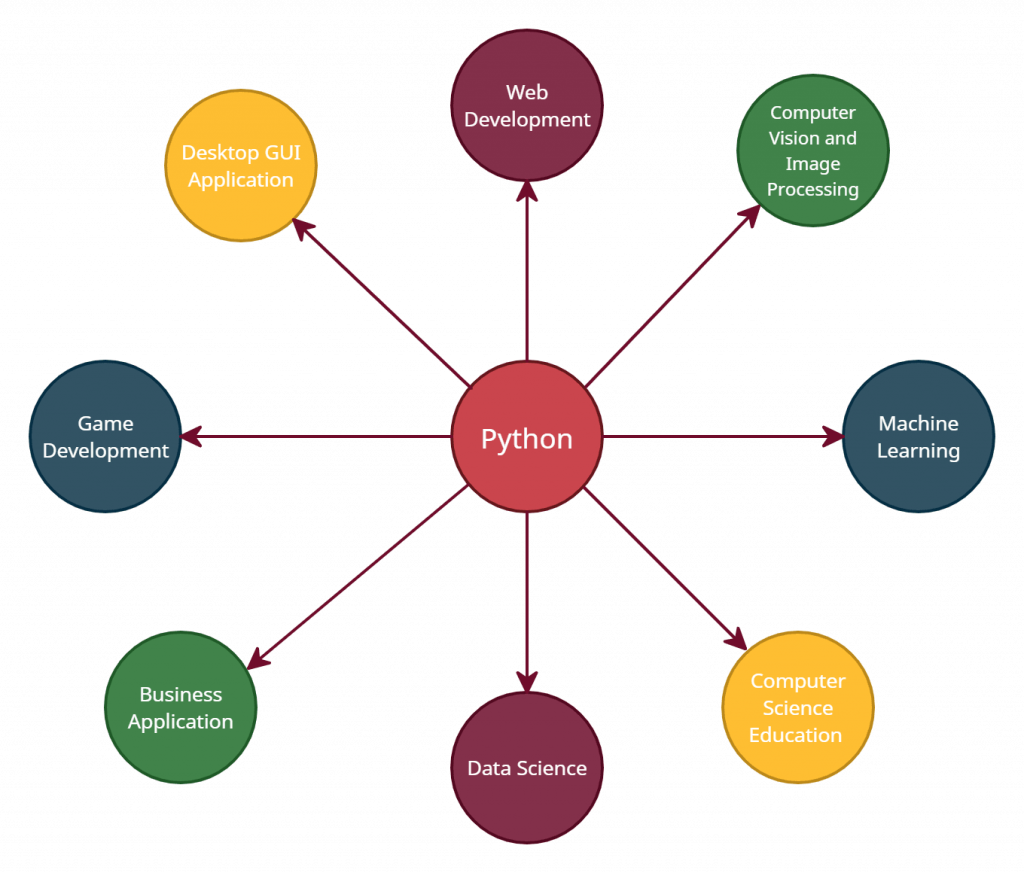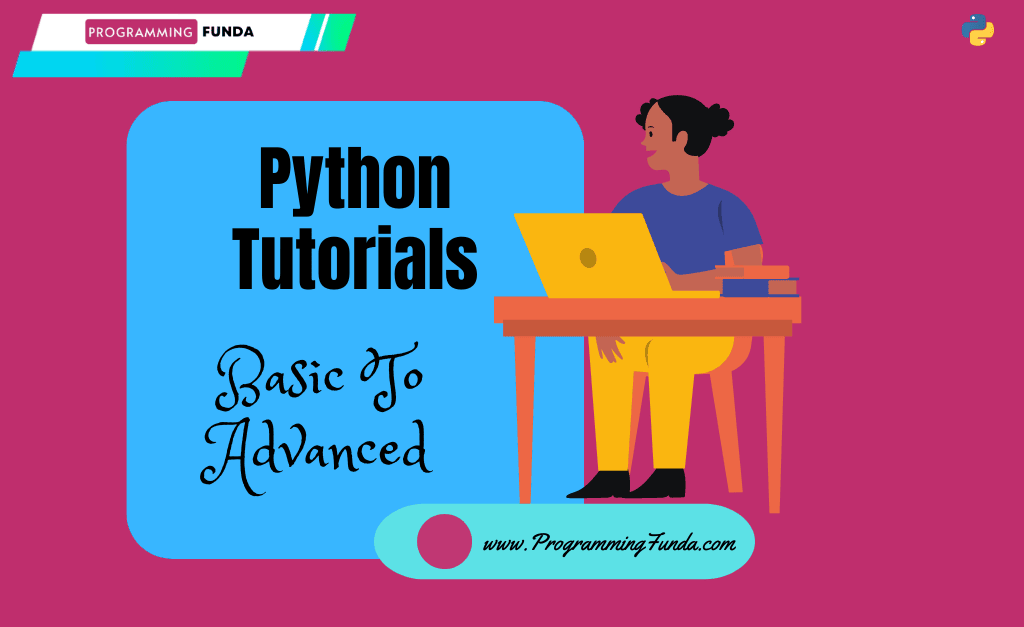Welcome to our Python Tutorial 🙏🙏
In this article, You will learn everything about Python programming from scratch to advanced. Our Python tutorial is designed for Beginners as well as Professionals. If you want to become a good Python programmer then this Online Python tutorial is going to be best for you because here we will cover all basic and advanced topics of Python programming with the help of proper syntax and examples.
Here we have mentioned all the topics of Python Programming, If we want to read any particular topic of Python then you can click on the particular link and jump to that article.
Before going through this Python tutorial, Let’s understand the brief description of Python Programming.
Headings of Contents
What is Python?
Python is one of the most popular programming languages. Python is a general-purpose, dynamic-typed, high-level programming language that is used for multi-purpose.
Python programming supports the concept of Object Oriented Programming to develop applications. Python is easy to learn to program. If you are coming from another program then Python will more easier to learn compared to other programming languages. Python programming is used to develop various types of applications like Web Applications, Enterprises, 3D, Machine Learning, Data Science, etc.
Python is dynamic type programming which means we don’t need to declare the data type of variables like C and C++. It is a more powerful programming language because it has huge Libraries. Python libraries make it easy to develop any application.
Nowadays Python programming is used in most trending technologies like AI, ML, Data Science, Graphs, etc.
History of Python
Python is a widely-used popular programming language and it was initially introduced in 1991 by Guido Van Rossum and developed by Python Software Foundation. The implementation of Python was started in 1998s by Guido Van Rossum at CWI Netherlands.
Guido Van Rossum started working on Python in the late 1998s after the successor of the ABC programming language and first released in 1991 0.9.0.
Python 2.0 was released in 2000 along with some features like list comprehensions, garbage collection, cycle-detecting, Unicode, etc.
Python 3.0 released in 2008 along with some extra features, was a major revision that was not completely backward compatible with earlier versions. Python 2 was discontinued in version 2.7.18 in 2020.
Features in Python
There are various features of Python available that make Python more attractive and popular. Here, we have mentioned some of the popular features of Python that we should know as Developers at least.

Open Source
Python is a free and open-source language that is freely available to everybody. Open source means you don’t have to pay anything to be used for Python just download Python from the official website install it on your machine and start using it.
Easy to Read
Python is a very developer-friendly language because it is a very easy-to-read language as compared to other programming languages like C, C++, Java, C#, PHP, etc. If you don’t know Python, Then you can easily learn Python in a few days or months. It’s very human-readable language along with straightforward statements.
Easy To Code
Python is a very easy-to-code language compared to other Programming languages like C, C++, C#, Java, PHP, etc. It provides a very easy and short syntax for writing code. You can learn Python in a few days or months and start work on Python. This is one of the best features of Python because you don’t have to put more effort into writing code in Python.
Python Standard Libray
This is one of the major reasons behind Python’s popularity from my point of view because it provides a rich library system. Python comes with lots of built-in libraries by default when you install Python on your machine. Besides Python’s built-in library, tons of external libraries are available hosted on the PyPI platform. I love Python because of this.
Portable
Portable means, You can execute the same Python code on a different platform like Windows, Linux, and macOS, known as Portable.
Suppose you have a Python code you wrote on a Windows machine and you want to execute the same code on a Linux machine then you have to just push the code on a Linux machine, install dependencies, and start executing. It works perfectly. You don’t have to change any bit of code to execute. As Such, There is no need to write the same code for different machines like Windows, macOS, and Linux.
High-Level Language
Python is a high-level language. When you write code in Python, you don’t need to remember the system architecture nor do manage the memory in Python. This is one of the key features of Python.
Cross Platform Language
Python supports multiple platforms like Windows, macOS, and Linux, that’s why it is called a Cross-Platform language.
Dynamically Typed Language
Python is a Dynamically typed language because you don’t need to define the data type of a variable before using it. It infers the data type of variable during the run time. This is also a good feature of Python.
Many programming languages like C, C++, etc need to declare the variable data type before run time but in Python, it’s not required because Python is dynamically typed. It decides the data type of variable during run time.
GUI ( Graphical User Support ) Support
Python provides various libraries to build GUI ( Graphical User Interface ) applications.PyQT5, Tkinter, and Kivy are some popular Python GUI libraries for building GUI applications. Besides these libraries, Python provides other libraries for GUI applications.
Interpreted
Python is an interpreted language because you don’t need to compile Python code like C, C++, Java, etc. It executes the Python code line by line at a time unlike other languages C, C++, Java, etc. This feature makes it very easy to debug the Python code and find what going wrong in Python code.
Object Oriented Language
Python supports OOPs ( Object Oriented Programming ) Concept. In the OOPs Concept, everything handles using of Classes and Objects that’s why it is called Object Oriented Programming Language. It supports multiple features of Python like Class, Object, Inheritance, Data Abstraction, Polymorphism, and Encapsulation.
Why you should learn Python Programming?
As you know Python is getting more popular nowadays from its usage. The only reason for Python’s popularity is used in various software domains. If you are a beginner in programming, Then you can go with Python language because it is very easy to learn compared to other languages.
Python provides large collections of built-in and external libraries that make made easy to work with large-scale or mini-projects.
Once you know Python, Then various software domain fields open for you, and you can choose any according to your knowledge base.
Applications That Developed By Python
Various applications can be developed by the Python programming language. Except for these applications, you can develop various other applications but these are the major ones.

- Web Development
- Desktop GUI Application
- Data Science
- Machine Learning
- Artificial Intelligence
- Automation
- Console Application
- Business Application
- Game Applications
- Computer Vision and Image Processing
Python Tutorials Libraries
Python Basics
- Python Introduction
- Python Installation
- Python path
- Python Variables
- Python Data Types
- Python Data Types and Type Conversion
- Python keywords
- Python literals
- Python comments
- Python operators
- Python PIP Tutorial
Python List Tutorial
- Python list
- List append() method
- List clear() method
- List count() method
- List copy() method
- List extend() method
- List index() method
- List insert() method
- List reverse() method
- List pop() method
Python Dictionary Tutorial
- Python Dictionary
- Dictionary clear() method
- Dictionary copy() method
- Dictionary fromkeys() method
- Dictionary get() method
- Dictionary items() method
- Dictionary key() method
- Dictionary pop() method
- Dictionary popitem() method
- Dictionary update() method
- Dictionary values() method
Python Operators
- Python Operators
- Python Arithmetic Operators
- Python Comparison Operators
- Python Assignment Operators
- Python Bitwise Operators
- Membership and Identity Operators
Python Built-in modules
Control Statement
- Python if statement
- Python while loop
- Python for loop
- Python break statement
- Python continue statement
- Python pass
Python Set Tutorial
- Python set tutorial
- What is frozen set in Python
- Set add() method
- Set clear() method
- Set copy() method
- Set difference() method
- Set difference_update() method
- Set discard() method
- Set intersection() method
- Set intersection_update() method
- Set isdisjoint() method
- Set issubset() method
- Set pop() method
- Set remove() method
- Set symmetric_difference() method
- Set union() method
Python OOPs Concepts
- Python OOPs Concepts
- Python class and object
- Python Inheritance tutorial
- Types of Inheritance in Python
- Python classmethod
- Python super method
- Python Abstract Class
- Static method in Python
- Instance method in Python
- self parameter
- Data hiding in Python
- Python Constructor
- Python Destructor
Python MySQL Tutorial
- MySQL Get Started
- MySQL Create Database
- MySQL Create Table
- MySQL Insert Into
- MySQL Select
- MySQL Where
- MySQL Order By
- MySQL Delete
- MySQL Drop
- MySQL Update
- MySQL Limit
Python Frameworks
Python Exercise
Python String Tutorial
- Python string tutorial
- String capitalize() method
- String casefold() method
- String center() method
- String count() method
- String endswith() method
- String expandtabs() method
- String find() method
- String format() method
- String index() method
- String isalpha() method
- String isalnum() method
- String isdecimal() method
- String isdigit() method
- String isidentifier() method
- String islower() method
- String isupper() method
- String isnumeric() method
- String isprintable() method
- String isspace() method
- String istitle() method
- String join() method
- String lower() method
- String lstrip() method
- String partition() method
- String replace() method
- String rindex() method
- String rfind() method
- String rstrip() method
- String rpartition() method
- String startswith() method
Python Other Concepts
- Python function tutorial
- Python lambda function
- Python f-strings
- Python Global, Local and Nonlocal variables
- Python global keyword
- Python modules tutorial
- Decorators in Python
- Dunder method in Python
- Python args and kwargs
- Type conversion in Python
- Iterators in Python
- Python @property decorator
- Read CSV files in Python
- Write CSV files in Python
- Python shallow and deep copy
- Higher-Order Function in Python
- Python context manager
- Python comprehension
- Monkey patching in Python
- What is frozen set in Python
- Python Regular Expression ( With Examples )
Python File Handling
Python Built-in Functions
- callable() function
- chr() function
- dict() function
- complex() function
- dir() function
- format() function
- exec() function
- hex() function
- id() function
- list() function
- isinstance() function
- issubclass() function
- min() function
- max() function
- type() function
- tuple() function
- vars() function
- zip() function
- divmod() function
- enumerate() function
- eval() function
- filter() function
- float() function
- exec() function
- frozenset() function
- input() function
- int() function
- iter() function
- len() function
- map() function
- pow() function
- reversed() function
- classmethod() method
- round() function
- super() function
- set() function
Each of the above Python articles is tested on our Python environment. We will mention approximately all the Python topics from time to time. To get a better experience, quickly bookmark this page in your browser.
Conclusion
So, In this Python tutorial, we have seen a brief description of the Python programming language and also Here we have mentioned almost all the basic to advanced topics of Python programming, that make it easy to learn.
If you wanna make your career as a Software Developer, Data Scientist, Data Engineer, or AI Engineer and searching for a good programming language, Then definitely you must go with Python programming language without any hesitation.
There are various reasons behind Python’s popularity are, easy to learn, easy to understand, and easy syntax rather than other languages and the most important thing is Python is used in various software domains.
If you found this article helpful, please share it with your friends who want to learn Python programming.
Have a Nice Day! 😊😊
Thanks for your valuable time … ❤️❤️🧑💻🧑💻







